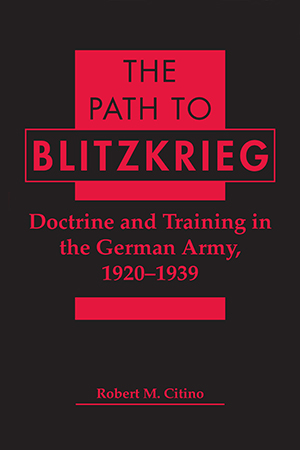Robert M. Citino
In 1939, the German army shocked and terrorized the world with Blitzkrieg, its form of mobilized warfare. How the Germans rebuilt their army after defeat in World War I—circumventing the prohibitions of the treaty at Versailles—is one of the major questions in military history.
Citino shows that German officers of the army of the Weimar Republic (the Reichswehr), men like General Hans von Seeckt, General Wilhelm Groener, and Colonel Oswald Lutz, initiated and carried out a thorough reform of the army's warfighting doctrine and capability that laid the groundwork for Hitler's seemingly effortless rearmament of Germany. Using largely unpublished materials from U.S. and German archives, he grounds his book in a study of key autumn maneuvers of the German army in the thirties. His analysis traces the smooth and inexorable development of the Reichswehr into the Wehrmacht, quite likely the finest military machine in history.
Robert M. Citino is senior historian at the National World War II Museum. He is the recipient of the Society for Military History’s 2021 Samuel Eliot Morison Prize for lifetime achievement.
"
Path to Blitzkrieg fills a gap in the historical research of the German Army.... Citino makes excellent use of unpublished sources.... The greatest value of Path to Blitzkrieg, however, lies in its destruction of Blitzkrieg myths."—Lieutenant-Colonel Ian Hope,
The Army Doctrine and Training Bulletin
"The relevance of Citino's work to problems current US forces face is painfully obvious."—LTC Scott Stephenson, Military Review
"Citino has done an outstanding job of dissecting the roots of the blitzkrieg doctrine."—The International History Review
"A well-written, well-organized, and superbly researched work.... [Citino] shows just how important character and intellect are to an effective military organization.... The abundance of translations Professor Citino provides throughout his text is what this reviewer found most satisfying.... What one reads in The Path to Blitzkrieg are the actual thoughts of field grade and junior officers, who not only developed German army theory in the interwar period, but also translated in into practice during the Second World War."—Charles E. White, Journal of Military History
"Citino presents a carefully drawn picture of German military developments in the 1920s and 1930s.... Military historians and professional soldiers can read this book with profit."—Joseph Robert White, History
"This is a splendid book. A major contribution to the literature not only on the German Army, but also on the development of doctrine and the way armies innovate in peacetime.”—Bruce Gudmundsson








